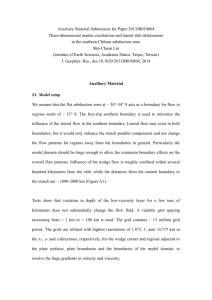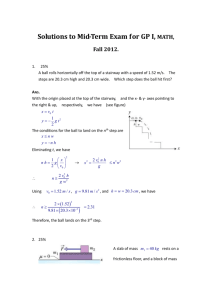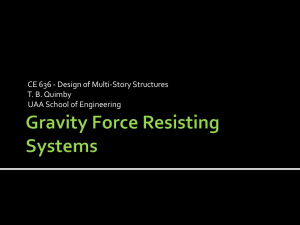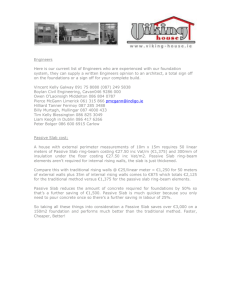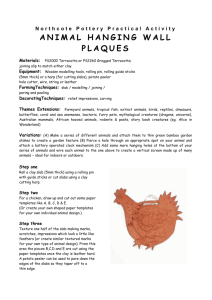Materials and Methods
advertisement
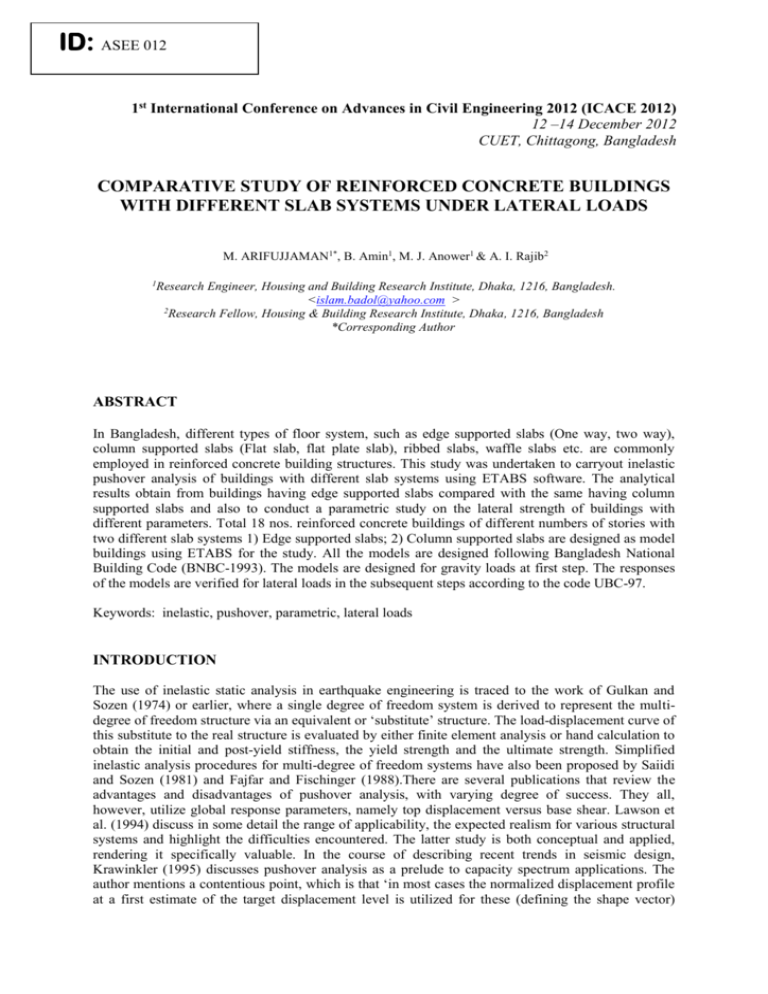
ID: ASEE 012 1st International Conference on Advances in Civil Engineering 2012 (ICACE 2012) 12 –14 December 2012 CUET, Chittagong, Bangladesh COMPARATIVE STUDY OF REINFORCED CONCRETE BUILDINGS WITH DIFFERENT SLAB SYSTEMS UNDER LATERAL LOADS M. ARIFUJJAMAN1*, B. Amin1, M. J. Anower1 & A. I. Rajib2 1 Research Engineer, Housing and Building Research Institute, Dhaka, 1216, Bangladesh. <islam.badol@yahoo.com > 2 Research Fellow, Housing & Building Research Institute, Dhaka, 1216, Bangladesh *Corresponding Author ABSTRACT In Bangladesh, different types of floor system, such as edge supported slabs (One way, two way), column supported slabs (Flat slab, flat plate slab), ribbed slabs, waffle slabs etc. are commonly employed in reinforced concrete building structures. This study was undertaken to carryout inelastic pushover analysis of buildings with different slab systems using ETABS software. The analytical results obtain from buildings having edge supported slabs compared with the same having column supported slabs and also to conduct a parametric study on the lateral strength of buildings with different parameters. Total 18 nos. reinforced concrete buildings of different numbers of stories with two different slab systems 1) Edge supported slabs; 2) Column supported slabs are designed as model buildings using ETABS for the study. All the models are designed following Bangladesh National Building Code (BNBC-1993). The models are designed for gravity loads at first step. The responses of the models are verified for lateral loads in the subsequent steps according to the code UBC-97. Keywords: inelastic, pushover, parametric, lateral loads INTRODUCTION The use of inelastic static analysis in earthquake engineering is traced to the work of Gulkan and Sozen (1974) or earlier, where a single degree of freedom system is derived to represent the multidegree of freedom structure via an equivalent or ‘substitute’ structure. The load-displacement curve of this substitute to the real structure is evaluated by either finite element analysis or hand calculation to obtain the initial and post-yield stiffness, the yield strength and the ultimate strength. Simplified inelastic analysis procedures for multi-degree of freedom systems have also been proposed by Saiidi and Sozen (1981) and Fajfar and Fischinger (1988).There are several publications that review the advantages and disadvantages of pushover analysis, with varying degree of success. They all, however, utilize global response parameters, namely top displacement versus base shear. Lawson et al. (1994) discuss in some detail the range of applicability, the expected realism for various structural systems and highlight the difficulties encountered. The latter study is both conceptual and applied, rendering it specifically valuable. In the course of describing recent trends in seismic design, Krawinkler (1995) discusses pushover analysis as a prelude to capacity spectrum applications. The author mentions a contentious point, which is that ‘in most cases the normalized displacement profile at a first estimate of the target displacement level is utilized for these (defining the shape vector) purpose. Attempts at improving the procedure have been made, with varying degree of rigor and success. The simplest and most pragmatic of which is the work of Sasaki et al. (1998). This comprises running several pushover analyses under forcing vectors representing the various modes deemed to be excited in the dynamic response. The pros and cons of the procedure were also discussed by Krawinkler and Seneviranta (1998). They concluded that not all analysis of the same structure under a set of district earthquake records are predicted by pushover analysis, a rather obvious conclusion that did not require inelastic dynamic analysis to prove. MATERIALS AND METHODS In order to conduct a parametric study of the lateral resistance of eight, ten and twelve storied buildings having two different types of slabs: 1. Flat plate slab 2. Beam slab Three model buildings are adopted in this study. The buildings have three length/ breath ratios: 1, 1.5, 2.0 all the buildings are designed using Bangladesh National Building code (BNBC-1993).It is worthy to mention that the buildings are designed for gravity loads at first step, and subsequently verified for lateral loads using UBC'97.The materials, loading and the designed sections of different basic components are described in the following sections. MATERIALS PROPERTIES Basic materials used in designing the model buildings are concrete and reinforcing steel and. To carry out designing the buildings, the materials parameters are selected first on the basis are availability in construction industry. The selected materials parameters are listed below: Table 1 Materials properties Materials Concrete Reinforcing Steel Properties Compressive Strength of Modulus of elasticity of Concrete, f’c=24 Mpa Concrete, Ec=4700√ f’c Mpa Yield stress of reinforcing steel, fy = 413 Mpa Modulus of elasticity of reinforcing steel, Es = 200X102 Mpa ANALYTICAL INVESTIGATION Pushover Analysis Pushover analysis is a static, nonlinear procedure using simplified nonlinear technique to estimate seismic structural deformations. It is an incremental static analysis used to determine the forcedisplacement relationship, or the capacity curve, for a structure or structural element. The analysis involves applying horizontal loads, in a prescribed pattern, to the structure incrementally, i.e. pushing the structure and plotting the total applied shear force and associated lateral displacement at each increment, until the structure or collapse condition. RESULTS By pushover analysis variation of displacement with base reaction for different slab system and different parameter of buildings are given below: Table 2 Analysis of Eight Storied Building Beam supported slab Flat plate slab without edge beam Plan Dimension Lateral resistance (KN) Displacement (mm) % of resistance higher than Lateral resistance (KN) Displacement flat plate (mm) slab 18.3mx18.3m 467.57 45 363.03 45 28.80 18.3mx27.45m 600.15 45 480.92 45 24.80 18.3mx36.6m 739.09 45 600.15 45 23.10 Average Of Percentage 25.5 Table 3 Analysis of Ten Storied Building Beam supported slab Flat plate slab without edge beam Plan Dimension Lateral resistance (KN) higher than Lateral Displaceme nt (mm) % of resistance resistance Displacement (KN) (mm) flat plate Average Of Percentage slab 18.3mx18.3m 462.06 45 353.68 45 30.64 18.3mx27.45m 598.19 45 469.22 45 27.48 18.3mx36.6m 730.37 45 587.07 45 24.40 27.5 Table 4 Analysis of Twelve Stored Building Beam supported slab Flat plate slab without edge beam % of resistance higher than Plan Dimension Lateral resistance (KN) Displacement (mm) Lateral resistance (KN) Displacement flat (mm) slab plate 18.3mx18.3m 456.54 45 344.38 45 32.50 18.3mx27.45m 596.15 45 457.52 45 30.30 18.3mx36.6m 721.65 45 574.04 45 25.70 Average Of Percentage 29.5 Graphical representations for different types of slab system where base reaction is varied for different story, i.e. Eight, Ten & Twelve Fig. 1 No. of story VS Base reaction for flat plate slab Fig.2. No. of story VS Base reaction for beam supported slab Graphical representations for different types of slab system where base reaction is varied for different L/B Ratio, i.e.1, 1.5, 2.0 Eight Storied Building Fig.3. Length width ratio VS Base reaction curve for flat plate slab and beam supported sla Ten Storied Building Fig.4. Length width ratio VS Base reaction curve for flat plate slab and beam supported slab Twelve Storied Building Fig.5. Length width ratio VS Base reaction curve for flat plate slab and beam supported slab DISCUSSION Lateral strength of eighteen reinforced concrete buildings with two different slab systems (1) beam supported slab; (2) flat plate slab 1. Base reaction is increased when L/B is increased. 2. When L/B is 1, 1.5, 2.0 then lateral load resistance capacities at beam supported slab is higher than the flat plate slab. 3. When the storey height is increase the base reaction is decrease. 4. For plan size 18.3mx18.3m, beam supported slab has 28.8% (For 8-storied), 24.8 % (For 10 storied) and 23.1% (For 12- storied) higher strength than that of the buildings with flat plate slabs. 5. For plan size 18.3mx27.45m, beam supported slab has 30.64% (For 8- storied), 27.48% ( For 10- storied) and 24.4% ( For 12- storied) higher strength than that of the buildings with flat plate slabs. 6. For plan size 18.3mx36.6m, beam supported slab has 32.56% (For 8- storied), 30.30% ( For 10- storied) and 25.7% ( For 12- storied) higher strength than that of the buildings with flat plate slabs CONCLUTION An analytical study on the lateral strength several storied buildings with two different slab systems (1) beam supported slab; (2) flat plate slab is carried out. The buildings are designed for gravity loads at first steps and subsequently verified for lateral loads. The conditions drawn in the study are as follows: 1. It is found that the buildings with beam supported slabs have higher lateral strength than with flat plate slab. 2. It is found that the lateral strength is decreased when the storey height is increased in both cases of two different slab systems. 3. Differences in lateral strengths are obtained for different length width ratio of the buildings. ACKNOLEDGEMENT All praise to our Allah, our creator, our sustainers, to whom we all have to return. We bear the witness that there is none worthy of worship except Allah and we also bear the witness that Muhammad (Peace be upon him) is Allah’s slave and messenger. Thanks to the member of my research partners for their valuable advice and encouragement. REFERENCES 1. ATC, 1996,Seismic Evaluation and Retrofit of Concrete Buildings, Volume 1,ATC-40 report ,Applied Technology Council , Redwood city ,California. 2. Bangladesh National Building Code (BNBC) 1993. 3. Building Seismic Safety Council .NEHRP Guidelines for the Seismic Rehabilitation of Buildings, FEMA-273.FederalEmergency Management Agency, Washington, DC, 20058 4. Chopra AK, Goel,RK.Amodal pushover analysis procedure for estimating seismic demands for buildings , Earthquake Engineering & Structural Dynamics 561582(doi:10.1002/eqe.144,2002;31. 5. ETABS ,Integrated Design and analysis software for Building System, Computer and Structure Inc, Berkley, California,UAS,Version9.0,2000. 6. Fijfar P, Gaspersic P. The N2 method for seismic damage analysis of RC buildings Earthquake Engineering & Structural Dynamics 1996; 25:31-46 7. Fijfar, P. and Fischinger, M.(1988)N2-method for Nonlinear Seismic Analysis of Regular Structures, Procedings of the Ninth World Conference on Earthquake Engineering (TokyoKyoto,Japan1988), Vol.5pp.111-116. 8. FEMA, 1997, NEHRP Guidelines for the Seismic Rehabilitation of Buildings, Developed by Buildings Seismic Safety Council for the Federal Emergency Management Agency(Report No.FEMA273),Washington,D.C. 9. Gupta A, Krawinkler H. Estimation of seismic drift demands for frame structures. 10. Earthquake Engineering & Structural Dynamics 2000;29:1287-1305. 11. Kim, S.and D’Amore,E (1999) pushover analysis procedures in earthquake engineering, Earthquake Spectra, Vol.15,No.3,Aaugust,pp.417-434. 12. Krawinkler H, Seneviratna GDPK. Pros and cons of a pushover analysis of seismic performance evaluation. Engineering Structures 1998;20(4-6):452-464. 13. Krawinkler H.(1995) New trends in seismic design methodology proceedings 10th ECEE, The Netherlands, Rotterdam,pp.821-830. 14. Krawinkler H, Seneviratna, G. D.(1998) Pros and cons of pushover analysis of seismic performance evaluation, Engineering Structures, Vol.20,No .4-6,pp.452-462.


